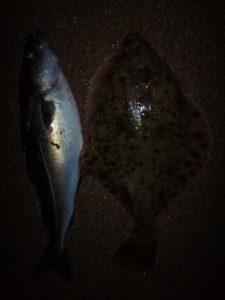
Flounder fishing – how to catch more flatties
If it wasn’t for the humble flounder, big parts of my fishing year would be fish-less. After the mackerel have left and before the cod arrive you can always count on the flounder to provide some sport. Don’t expect screaming runs, but on the right tackle flounder fishing can be a lot of fun.
Fish as light as you can

To enjoy flounder fishing to the most you have to accept the fish’ limitations. Like most smaller flat fish, flounder don’t put up much of a fight on heavy tackle. But because flounder are often found close in, you rarely need heavy beach equipment. In estuaries a 1 or 2 oz lead is often more than enough. A carp rod can easily deal with weights like that, or even better, a light spinning rod. If you do a lot of flounder fishing in calm conditions it might be worth investing in a ‘flattie rod’. These rods are often rated for 1-3oz. They have enough backbone to cast these weights combined with a very sensitive tip. The Shakespeare Salt XT ‘Flattie’ is a good budget option.
Find the fish holding hotspots

Estuaries or areas near estuaries are real flounder territory. Flounders like gulleys and channels, because a lot of food collects there. They also seem to use these deeper areas to move onto the beach once it starts flooding. Areas with a lot of holes can also be productive. It is a good idea to start at low tide and mark the spots you think the fish will visit once the tide comes in. Sticks and pieces of driftwood pushed into the sand are perfect for this task because you can still see them when the tide comes in.
Don’t cast too far

Flounder like to stick close to the beach and gobble up all the food that becomes available once the beach starts flooding. An underhand swing is often enough. If you’re wearing waders you can just drop your bait into a hole or gulley. You’ll be surprised how quickly – and in how little water – the flounder will find your bait. Sometimes the fish are further out, but in my experience it’s always best to start close in and then work your way out.
Vary your baits

Flounder take a variety of baits, but depending on the area some baits seem more effective than others. Ragworm is probably the best bait, but mackerel and lugworm are real killers too. Take several baits with you so you can find out what works best on the day. In my experience, if they’re after sand eels, mackerel works best, while after a storm worm baits are more successful. Peeler crab is probably the best bait in the spring.
Of course it largely depends on what you can lay your hands on. Finding peelers can take a lot of time and they can be very expensive if you buy them in the shop. I always have some self-caught mackerel in the freezer and can easily dig some blow lug on my way to or from work so those are the baits I use most of the time. Adjust the hook sizes to the bait you are using. With small worm baits, you can go as small as a size 6 but for fish baits or crab a size 1 is a better option.
Keep it moving
Flounder are attracted by movement. I always try to choose a weight that still moves in the tide. If plain weights are blown away too fast I use flat or pyramid shaped leads. The moving rig stirs up the sand which attracts the fish. Also the tide pushes the weight into holes and gulleys where flounder like to hide. I don’t use grip leads unless I really have to.
Vary your rigs
A two hook flapper is probably the best all-rounder flounder rig, but sometimes a running ledger is a better choice. The fish feels less resistance, especially if you keep your line a bit slack. Sometimes it can help to add attractors to your rigs, like beads and sequins. For more info on rigs, see my rigs article.
Flounder fishing with lures
They might not look it, but flounder are tremendous predators and can be successfully targeted with lures. Small soft plastics fished on a jig head are the best. As there is no need to cast very far you can use the lightest of lrf set-ups.
Don’t limit yourself to daylight hours

Flounder fishing in the dark can be just as productive as during the day. You are also more likely to have interesting by-catches like coalfish or cod.
If you have any flounder fishing tips you’d like to share, please do so in the comment section below.
And if you’d like to receive an email every time I publish a new post, please subscribe to my newsletter. Tight lines!
Disclosure: if you purchase anything using the links in this blog post, I might make a commission. Affiliate programs and affiliations include, but are not limited to, the eBay Partner Network. It doesn’t cost you a penny more to buy via these affiliate links (and you don’t have to use them of course) but it helps me to keep this blog going. Thanks!